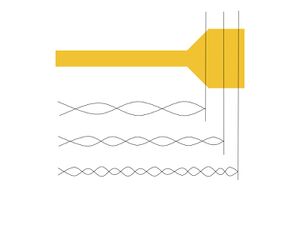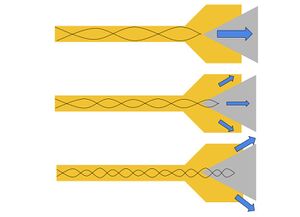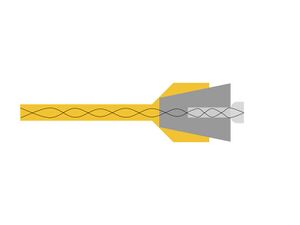Courses:PHYS341/2021/Project5
Physics of Trumpet Mutes
Brass Mutes
Certain instruments, such as trumpets and trombones, can be affixed with external devices to alter their sound. Despite being generally referred to as “mutes,” these devices have various designs that can do far more than just dampen the sound of the instrument; they have the capability to alter other aspects of the sound. In essence, these devices alter the mechanical structure of the instrument to redirect air and soundwaves, in turn varying other fundamental elements of sound, such as amplitude, frequency, and timbre.
To understand how mutes change the physics of sound within a trumpet, one must first understand how an unmuted trumpet operates. As with all brass instruments, a musical note begins in a trumpet when a player blows air into the mouthpiece while allowing their lips to vibrate. These vibrating lips allow small puffs of air into the instrument, producing a standing wave provided that the lip vibration’s frequency matches one of the resonant frequencies of the instrument. Another important and unique feature of the trumpet is the flared bell, which allows nodes of different standing waves to terminate in different locations (see figure 1). This factor allows notes to resonate well even when their wavelengths are altered.

Straight Mutes
The first and most commonly used brass mute is the straight mute. This mute is most often shaped either like a straight cone or with a curve and can be constructed out of cardboard, plastic, fibreglass, or aluminum. The tip of the stem of the mute is made of a more permeable material, which can allow air to pass through to the hollow interior. The mute typically has three pieces of cork around the stem to hold it in place against the bell of the trumpet. This means that the mute does not completely block the bell of the trumpet; rather, air is allowed to escape along the edges of the bell. This phenomenon is instrumental in predicting the effect of the mute on the trumpet’s sound.
Straight mutes cause lower-frequency waves to be absorbed by the mute while allowing higher-frequency waves to escape past the mute (see figure 2). This effectively filters out sounds below a certain frequency, allowing higher notes to resonate and causing the trumpet to produce a higher, more shrill sound. With the mute blocking a portion of the sound coming from the trumpet, one might think that the volume would be reduced, but as higher frequency pitches are easier for the human ear to pick out, straight mutes are regarded as some of the only mutes capable of playing loudly. In addition to affecting the pitch and volume of the produced sound, the mute also alters the timbre. As soundwaves collide with the mute and each other, their shapes change in subtle ways to affect the colour of the produced tone. This depends heavily on the material of the mute used, as it has been noted that cardboard or plastic straight mutes absorb sound waves to produce a stuffy sound, whereas metal mutes allow a brighter, more piercing tone.

Straight mutes are the most commonly used trumpet mutes and find applications in both classical and jazz settings.
This video showcases a quartet of brass instruments playing with straight mutes.
Harmon Mutes
The Harmon mute carries quite a few differences from the straight mute, and as such, produces a much different sound. This mute is always constructed with aluminum and has a larger cylindrical front, with the bulb tapering into a cork lip that completely blocks the airflow of the bell. The mute is also unique in that it has a second piece: a stem that fits into the front of the mute and alters the sound further. With the single cork piece surrounding the mute, the Harmon creates a seal and directs all air blown through the trumpet into the mute.
The sound of the Harmon mute is heavily dependent on the position of the stem. Without the stem, the Harmon mute somewhat emulates the curve of a trumpet bell, albeit with a much smaller aperture to let sound escape. Once again, this serves to exclude certain frequencies, as standing waves that terminate too far in the mute are stuffed by the troughs at the end of the Harmon (see figure 3).

The small mid-to-high range of allowed frequencies produces a lower, subdued sound. With the stem in, however, the trumpet takes on a drastically different sound. The straight stem forms a cylindrical tube, with its own properties as a musical instrument. Provided the standing wave moving through the trumpet can resonate with the stem, it can continue through with somewhat similar qualities, save for an altered timbre (see figure 4).

In addition to these options, a trumpeter playing into a Harmon mute can manipulate the stem while they play, changing the length of the tube to employ elements of both sounds in their play.
The Harmon mute became a staple of jazz music and is renowned for the unique sounds it is capable of producing.
Miles Davis plays with a stemless Harmon mute on this recording of "Stella by Starlight."
Plunger
The plunger differs from the mutes discussed so far in a variety of ways. This mute is quite literally the rubber head of a toilet or sink plunger, with the handle removed and, occasionally, a hole cut in the centre to allow air to pass through with greater ease. Some mute companies now manufacture plungers made for the purpose of muting a trumpet, but they mostly share these characteristics. Rather than affixing the mute to the instrument in some way, trumpeters hold the mute with their left hand in front of the instrument, and alternate between opening and closing the mute to produce interesting sounds and effects.
Similar to the stem of the Harmon mute, the plunger can be manipulated by the trumpeter during play, which allows them to change the sound of a held note. When the plunger is held over the bell, it blocks a portion of the sound coming from the trumpet. However, the spherical shape of the plunger allows some pressure to build up, rather than just be dispersed. As the plunger is moved away the bell is opened and air rushes out once again, creating a short and loud burst of sound (see figure 5).

This capability allows the trumpeter to produce the characteristic "wah-wah" effect with a plunger, gradually opening the plunger to produce a rush of sound. The plunger can also be moved rapidly, to produce sounds similar to speech or moaning.
The trumpet solo from this recording of "Who Me?" beginning at 2:04 utilizes a plunger.
References
- Leeman, Dan. "Trumpet Mute Types And How They're Used." Notestem, 8 Sept. 2020, https://www.notestem.com/blog/trumpet-mute-types/
- Summer, David. "Brass Instrument Mutes." Summersong, 2013, https://www.summersong.net/music-teacher/trumpet-lessons/brass-instrument-mutes/
- Formosa, Gregory. "Acoustic Harmonicity and Input Impedance for Various Bb Trumpet Mutes." Department of Mechanical Science and Engineering University of Illinois at Urbana-Champaign, 2017, https://courses.physics.illinois.edu/phys406/sp2017/Student_Projects/Spring10/Greg_Formosa/G_Formosa_P498POM_Final_Report_Sp10.pdf
- Armstrong, Zachary T., "The Acoustics of Harmon Mutes." Summer Research. 265. 2016, https://soundideas.pugetsound.edu/summer_research/265
- Martínez-Montejo, Erika et. al., "Characterisation of brass instruments with mutes through experimental means and finite-element simulations." Numerical Computation in Musical Acoustics, 2016, http://www.ica2016.org.ar/ica2016proceedings/ica2016/ICA2016-0399.pdf
- "Trumpet Straight Mute Demonstrations." YouTube, uploaded by Virtuosity Musical Instruments, 15 May, 2017, https://www.youtube.com/watch?v=8mzgNbf1QYU
- "Humes & Berg Stonelined Symphonic Aluminum Straight Trumpet & Cornet Mutes 106A." YouTube, uploaded by Humes Berg, 23 May, 2013, https://www.youtube.com/watch?v=k2sA5S6S1KA
- "MHT123 - Trumpet Harmon Mute." YouTube, uploaded by mutecinc, 12 Oct, 2010, https://www.youtube.com/watch?v=pVSlrVEKscU
- "Miles Davis - Stella by Starlight (Official Audio)." YouTube, uploaded by Miles Davis, 14 May, 2013, https://www.youtube.com/watch?v=XGx1HvLV_NQ
- "How to Play Trumpet with a Plunger Mute." YouTube, uploaded by Jazz at Lincoln Center's JAZZ ACADEMY, 15 Jul, 2014, https://www.youtube.com/watch?v=zMtggA3E79Y
- "Count Basie Orchestra - Who Me? (1959)." YouTube, uploaded by JazzBreakTV, 14 May, 2013, https://www.youtube.com/watch?v=iHxpWbW5AjY